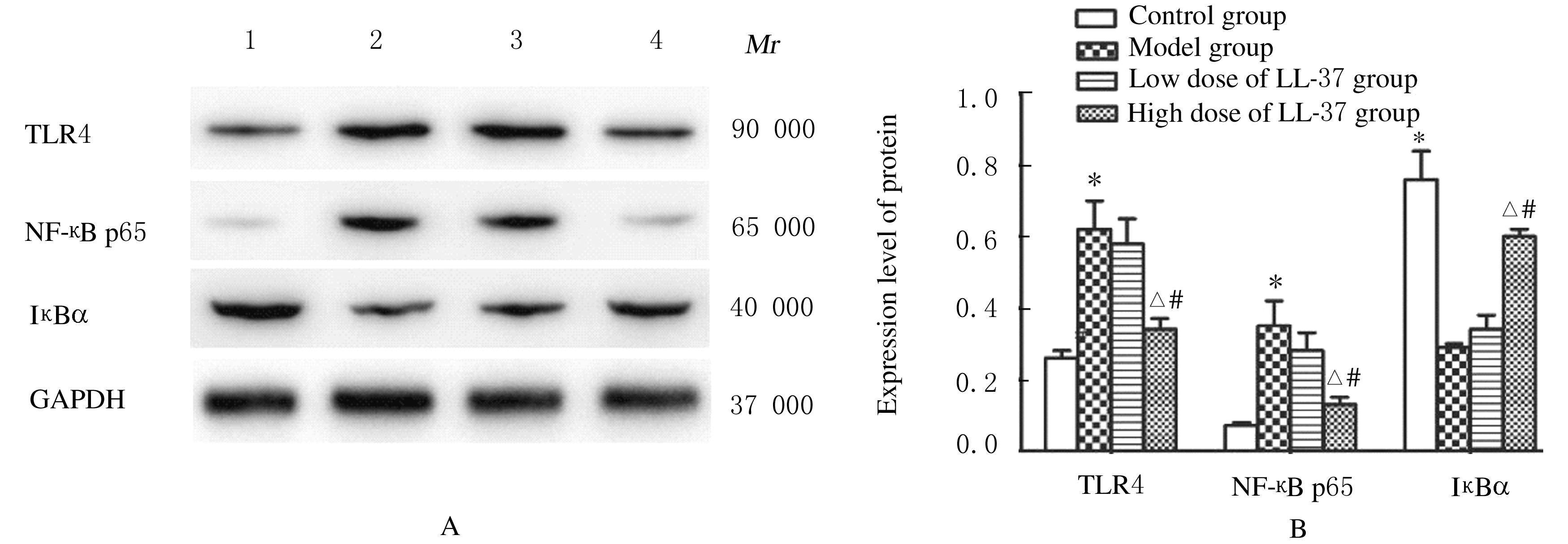| [1] |
Yanqing LI,Fang ZHAO,Rui GAO,Xin WU,Xiaobin NIU.
Effect of Tongguan Xiaozheng Decoction on levels of serum inflammatory factors in rats with tubal inflammatory infertility and its mechanism
[J]. Journal of Jilin University(Medicine Edition), 2022, 48(2): 383-390.
|
| [2] |
Qi LIU,Xin XU,Zhenggen WANG.
Effect of calycosin on intestinal mucosal barrier function in cirrhosis rats and its mechanism
[J]. Journal of Jilin University(Medicine Edition), 2022, 48(2): 391-398.
|
| [3] |
Na HAN,Fanping LIU,Yanqing TIAN,Zhiqing ZHENG,Weiming LANG,Qian WANG,Yatao LIU,Jianguang ZHU.
Regulatory effect of miRNA-27a on immune function in experimental pulmonary tuberculosis rats and its mechanism
[J]. Journal of Jilin University(Medicine Edition), 2022, 48(1): 104-110.
|
| [4] |
Zhen LIU,Minglei HAN,Jiajia CUI,Yonglan HOU,Guangcui XU.
Protective effect of losartan on acute myocardial infarction in rats and its mechanism
[J]. Journal of Jilin University(Medicine Edition), 2021, 47(6): 1397-1406.
|
| [5] |
Jie GONG,Zehua LEI,Yuanwei ZHANG,Xiong HUNANG,Bo DU,Zhixu WANG.
Improvement effect of miR-490-3p over-expression on non-alcoholic fatty liver disease in rats and its mechanism
[J]. Journal of Jilin University(Medicine Edition), 2021, 47(6): 1495-1501.
|
| [6] |
Zhenjie MA,Lan MA,Zhen JIA.
Effect of celiac plexus block on stress response and immune inflammation of rats after partial hepatectomy and its mechanism
[J]. Journal of Jilin University(Medicine Edition), 2021, 47(2): 407-413.
|
| [7] |
Lijun YAN,Shengquan TONG,Jing LIU,Dongmei GAO,Nanfang CHEN,Jie HU.
Therapeutic effect of total glucosides of paeony in model rats with rheumatoid arthritis by mediating TLR4/NF-κB signaling pathway and its mechanisim
[J]. Journal of Jilin University(Medicine Edition), 2021, 47(2): 390-396.
|
| [8] |
Shurong ZHANG,Qiying ZHANG.
Regulatory effect of luteolin on Aspergillus fumigatus keratitis through TLR4/MyD88 signaling pathway in rats
[J]. Journal of Jilin University(Medicine Edition), 2021, 47(2): 315-322.
|
| [9] |
Jiancheng HUANG,Shichao GUO,Pujuan LIU,Yanbo DONG,Hongying LI,Ying LYU.
Protective effect of crocin on myocardium injury induced by ischemia and hypoxia in rats and its mechanism
[J]. Journal of Jilin University(Medicine Edition), 2021, 47(1): 102-109.
|
| [10] |
WAN Qi, YU Baogang.
Effects of miR-125b on proliferation and migration of cardiac fibroblasts by TLR4/NF-κB signaling pathway
[J]. Journal of Jilin University(Medicine Edition), 2020, 46(02): 286-291.
|
| [11] |
ZHAO Miao, WANG Yi, ZHANG Ying, FENG Yumei, CAO Yawen, JIANG Haisen, LI Wei.
Improvement effect of curcumin on cognitive function in mice with sleep deprivation and its mechanism
[J]. Journal of Jilin University(Medicine Edition), 2019, 45(06): 1373-1378.
|
| [12] |
LIU Jianming, LIU Chenchen, LIU Xinmin, ZENG Ming, JIANG Qun.
Long term toxicity of chelerythrine on lung tissue of rats and its effect on expression of NF-κB in lung tissue
[J]. Journal of Jilin University(Medicine Edition), 2019, 45(03): 518-523.
|
| [13] |
ZHAI Xiaoya, FENG Qiao, WEI Riming, CHEN Ye, HU Tingting, FENG Leping.
Regulation effect of endogenous nicotinamide phosphoribosyltransferase on Vimentin expression of glomerular cells in high concentration of glucose
[J]. Journal of Jilin University Medicine Edition, 2017, 43(05): 867-873.
|
| [14] |
YANG Kun, TIAN Zhenzhen, WANG Shuhua, XIU Ming, GUO Xiangling, QI Lina, LI Min, SUN Li, GAO Runping.
Effect of LPS-TLR4 pathway in hepatic fibrogenesis of rats with chronic alcohol intake
[J]. Journal of Jilin University Medicine Edition, 2015, 41(04): 751-755.
|
| [15] |
GOU Xiangbo, BAI Jing, GUO Jing, HAN Shuying.
Protective effect of Fufang KuQiaomai on myocardial injury of diabetic rats
[J]. Journal of Jilin University Medicine Edition, 2015, 41(01): 83-87.
|
 ),Shaowen TAN1
),Shaowen TAN1









